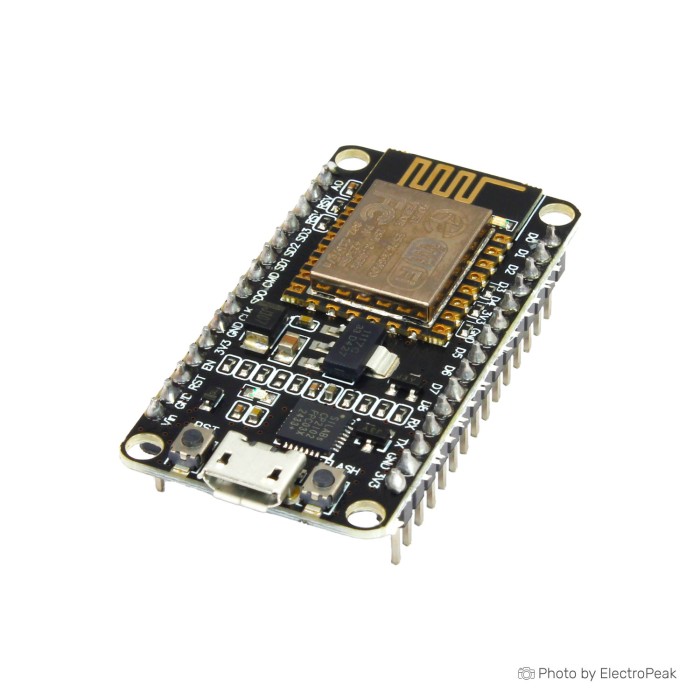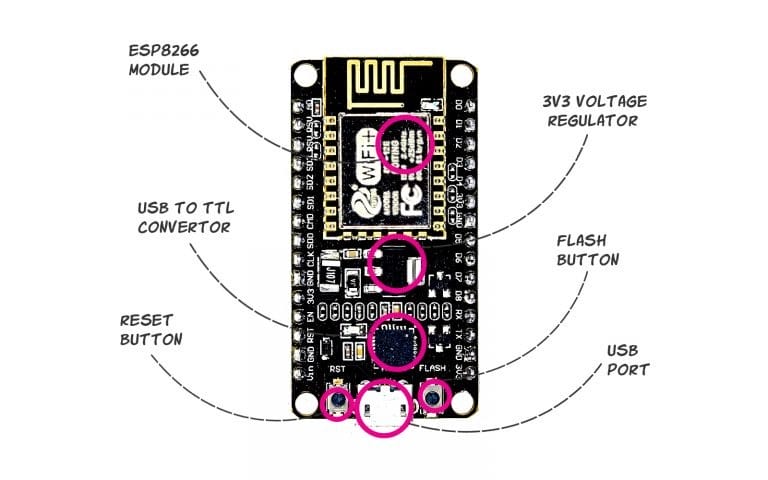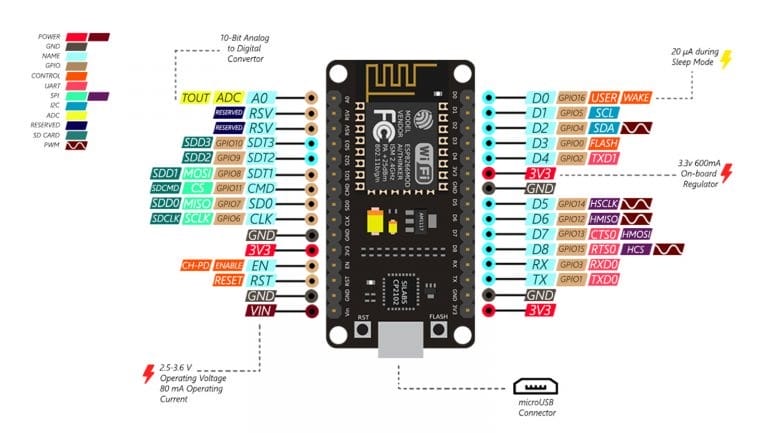NodeMCU is a development board that utilizes the ESP8266 module. It simplifies the development process by providing a ready-to-use platform with built-in USB-to-serial programming and voltage regulation.
NodeMCU ESP8266 CP2102 Wi-Fi Development Board
Volume discounts:
- +25 4 % $2.8400
- +100 5 % $2.7900
- +300 7 % $2.7300
- +500 9 % $2.6800
- +1000 11 % $2.6200

The NodeMCU ESP8266 CP2102 is a versatile and popular development board that integrates the ESP8266 Wi-Fi module with the CP2102 USB-to-Serial chip. This compact board is designed for easy prototyping and development of IoT (Internet of Things) projects. With built-in Wi-Fi capabilities and USB connectivity, the NodeMCU ESP8266 CP2102 offers a convenient platform for developers to create and experiment with connected devices, sensor networks, and various IoT applications.
Its compatibility with the Arduino IDE and a broad range of libraries makes it accessible to both beginners and experienced developers, providing a seamless and cost-effective solution for wireless communication and IoT development.
Key features of NodeMCU ESP8266 CP2102 Wi-Fi Development Board
- ESP8266 Wi-Fi Module: Integrates the ESP8266 Wi-Fi module, providing wireless connectivity for IoT projects. The ESP8266 is capable of connecting to Wi-Fi networks, making it suitable for applications that require internet communication.
- USB-to-Serial Conversion (CP2102): Features the CP2102 USB-to-Serial chip for easy interfacing with a computer. This allows for convenient programming and communication with the module using the USB port.
- Arduino IDE Compatibility: Supports programming using the Arduino Integrated Development Environment (IDE). This compatibility simplifies the development process, making it accessible to a wide range of developers familiar with the Arduino platform.
- GPIO Pins: Provides General Purpose Input/Output (GPIO) pins, allowing for versatile interfacing with sensors, actuators, and other electronic components. These pins support digital input/output, analog input, PWM, and other functionalities.
- Low Cost and Compact Design: The NodeMCU ESP8266 CP2102 module is cost-effective, making it accessible for hobbyists, students, and professionals alike. Its compact design makes it suitable for projects with limited space requirements.
Specifications of NodeMCU ESP8266 CP2102 Wi-Fi Development Board
- Serial/USB Chip: CP2102
- Output Power(dBm):5 @802.11b Mode
- Flash Memory(Mb): 4
- Size (Length x Width x Height)(mm): 49 x 24 x 13
- Weight (g): 8
- ADC: 1 channel of 10-bit precision SAR ADC
- UART interfaces: 2 UART interfaces with support for flow control
- PWM outputs: 4 PWM pins to control things like motor speed or LED brightness
- SPI and I2C interfaces: Two SPI and one I2C interfaces for connecting various sensors and peripherals
- I2S interface: One I2S interface for adding sound to your project
- Clock speed: Up to 80 MHz
Using Tips of NodeMCU ESP8266 CP2102 Wi-Fi Development Board
When working with the NodeMCU ESP8266 CP2102 Wi-Fi Development Board, consider the following tips to ensure smooth integration and optimal performance:
- Power Supply: Provide a stable and sufficient power supply within the recommended voltage range (typically 4.5V to 9V). Ensure that the power source can deliver enough current to meet the module's requirements.
- USB-to-Serial Drivers: Install the necessary USB-to-serial drivers for the CP2102 chip on your computer before connecting the NodeMCU to the USB port. This ensures proper communication between the development board and the computer.
- NodeMCU Flashing Mode: To upload new firmware or sketches, ensure that the NodeMCU is in flashing mode. Normally, this is done automatically. Otherwise, hold down the "flash" button, press the œreset button, and then release the œflash button.
- Programming Mode for Arduino IDE: In the Arduino IDE, select the correct board ("NodeMCU 1.0 (ESP-12E Module)") and COM port. When uploading sketches, press and hold the flash button on the NodeMCU until the upload process begins (optional).
- Wifi receiving range: The onboard antenna of this module is able to receive the Wi-Fi signal with the appropriate strength. The distance of this module from Wi-Fi transmitters should not be more than 10 meters. Of course, this distance also depends on the power of the transmitter.
NodeMCU ESP8266 CP2102 Wi-Fi Development Board Pinout
Below, you can see the pinout of NodeMCU ESP8266 CP2102 Wi-Fi Development Board. Each of the pins has a special function. For more details about the pinout of this module and other ESP8266 based modules, you can read this page.
Power and Reset:
- 5V: External 5V power supply.
- GND: Ground.
- VIN: 5V or higher power supply
- RST: Reset program running now
GPIO Pins:
- 17 multipurpose GPIO pins
Peripheral ports :
- I2C, UART, SPI(HSPI & SSPI)
Who is recommended to buy NodeMCU ESP8266 CP2102 module?
The NodeMCU ESP8266 CP2102 module is recommended for a diverse range of individuals and professionals who are interested in or working on Internet of Things (IoT) projects and wireless communication applications. Here are the recommended users for the NodeMCU ESP8266 CP2102 module:
- IoT Enthusiasts: Hobbyists and individuals interested in exploring IoT concepts, building smart devices, and creating connected projects can benefit from the simplicity and versatility of the NodeMCU ESP8266 CP2102 module.
- Prototypers and Makers: Prototypers and makers who want to quickly prototype and test IoT ideas can leverage the NodeMCU ESP8266 CP2102 module due to its easy integration with the Arduino IDE, GPIO pins, and built-in Wi-Fi capabilities.
- Developers and Programmers: Developers and programmers familiar with the Arduino IDE or Lua scripting language can use the NodeMCU ESP8266 CP2102 module to build connected applications, prototype IoT solutions, and experiment with wireless communication.
- Embedded Systems Engineers: Embedded systems engineers looking for an affordable and feature-rich platform for IoT projects can choose the NodeMCU ESP8266 CP2102 module for its compatibility with existing libraries, support for over-the-air updates, and community-driven development.
Pros and Cons of NodeMCU ESP8266 CP2102 Wi-Fi Development Board
Pros:
- Affordability: The NodeMCU ESP8266 is cost-effective, making it accessible for hobbyists, students, and developers with budget constraints.
- Wi-Fi Connectivity: Built-in Wi-Fi capabilities allow for wireless communication, making it suitable for Internet of Things (IoT) and connected projects.
- Arduino IDE Compatibility: Supports programming using the Arduino Integrated Development Environment (IDE), making it user-friendly for those familiar with Arduino.
- Compact Design: The small form factor makes it suitable for projects with space constraints and prototyping on a breadboard.
- Onboard USB-to-Serial: Features the CP2102 USB-to-Serial chip, simplifying the connection and programming of the board via USB.
- Ease of Use: Suitable for beginners due to its simplicity, compatibility with Arduino, and a straightforward programming process.
Cons:
- Limited GPIO Pins: The number of GPIO pins is limited compared to some other microcontroller platforms, which might be a constraint for projects requiring many pins.
- Lower Processing Power: The ESP8266 chip has less processing power compared to more advanced microcontrollers, limiting performance for computationally intensive tasks.
- Limited Analog Pins: The board has a limited number of analog pins, which may be insufficient for projects requiring multiple analog inputs.
- Limited Flash Memory: Onboard flash memory is limited, potentially causing constraints for projects with large firmware or data storage requirements.
- Lack of External Antenna connector: The onboard antenna may limit Wi-Fi range. Also there is no external antennas sockets on the board.
What you need for getting started with NodeMCU ESP8266 CP2102 Wi-Fi Development Board?
To get started with the NodeMCU ESP8266 CP2102 Wi-Fi Development Board, you'll need the following:
- USB Cable (Micro USB): A micro USB cable is required to connect the NodeMCU board to your computer. This cable serves both as a power source and a means for programming the board.
- Computer: You'll need a computer to write, compile, and upload code to the NodeMCU board. The development environment can be the Arduino IDE, PlatformIO, or any other compatible IDE.
- USB-to-Serial Driver (CP2102 Driver): The NodeMCU ESP8266 CP2102 Board uses the CP2102 USB-to-serial converter. Install the CP2102 driver appropriate for your operating system.
- Optional: Breadboard and Jumper Wires: If you're working with external components or sensors, having a breadboard and jumper wires will help you create circuits on a temporary basis.
- Power Source: The NodeMCU board can be powered via the USB connection, but if you want to deploy it in a standalone application, you'll need a suitable power source. This could be a USB power adapter, a portable power bank, or a dedicated power supply.
FAQs
What is NodeMCU?
What is the ESP8266?
The ESP8266 is a low-cost Wi-Fi module with a built-in microcontroller (Tensilica Xtensa) designed for IoT applications. It gained popularity for its affordability, small size, and ease of use.
What is the difference between ESP8266 and ESP32?
The ESP32 is an upgraded version of the ESP8266, featuring dual-core processors, more GPIO pins, Bluetooth support, and additional features. ESP8266 is simpler and more cost-effective, while ESP32 offers more capabilities.
How can I program the NodeMCU ESP8266 CP2102 Wi-Fi Development Board?
The ESP8266 can be programmed using various development environments, with the Arduino IDE being one of the most popular. Additionally, platforms like PlatformIO and Lua are also used for programming ESP8266. If you are using Arduino IDE, you can gain more information by reading “Beginner’s Guide to Get Started w/ ESP8266 on Arduino IDE”. Also if you are interested in Python language, you can read “How to Program MicroPython on ESP8266”.
Who is not recommended to buy NodeMCU ESP8266 CP2102 Wi-Fi Development Board?
While the NodeMCU ESP8266 development board is versatile and suitable for a broad range of users, there are certain scenarios where it might not be the best choice. Here are situations where the NodeMCU ESP8266 dev board might not be recommended:
If your project demands high processing power or requires advanced features not provided by the ESP8266 (such as high precision ADC or wide range of interface pins) , you might want to consider more powerful platforms such as the ESP32 or other microcontroller/microprocessor options. Also, if your project involves storing a substantial amount of data or requires extensive use of flash memory, you may have better choice than ESP8266.
Is ESP8266 faster than Arduino?
Comparing the speed of the ESP8266 and Arduino microcontrollers directly depends on the specific models being considered. In terms of clock speed alone, the ESP8266 generally operates at higher frequencies than some of the standard Arduino microcontrollers.
Can the ESP8266 be powered with 5V?
While the ESP8266 operates at 3.3V, it often has a voltage regulator that allows it to be powered by a 5V source through the Vin pin. However, GPIO pins are not 5V tolerant, so external components should operate at 3.3V.
What is the maximum range of Wi-Fi communication on the ESP8266?
The Wi-Fi range depends on various factors, including the environment and obstacles. In the basic model of this model, you can experience conditions similar to an old Android phone. In optimal conditions, the ESP8266 can typically achieve a range of around 100 meters.
Is the ESP8266 open source?
Yes, the ESP8266 module and its development tools are based on an open-source platform. Espressif, the company behind the ESP8266, provides the necessary software development kits (SDKs) and documentation for developers to work with the module.
If you're looking for alternative microcontroller boards with capabilities similar to the ESP8266 (NodeMCU), especially in terms of built-in Wi-Fi and ease of use, here are some alternatives:
Is there any alternative similar microcontroller boards to use instead of NodeMCU?
Remember to consider factors such as GPIO pin count, form factor, and additional features when choosing a board. Most of these alternatives can be programmed using the Arduino IDE or other popular development environments, providing a similar programming experience to the NodeMCU ESP8266.







Please complete your information below to login.
Sign In
Create New Account